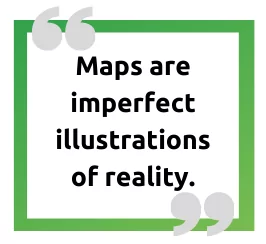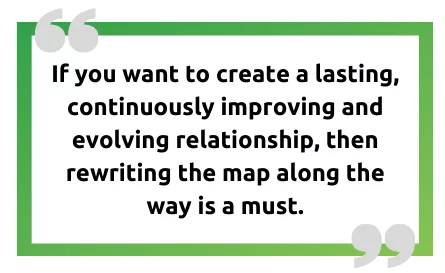Insights
Out of scope is not out of mind. This mantra is something we take to heart at Br8kthru and is a signature component of one of our core values: continuous improvement.
Even before beginning an official engagement, strategic marketing partners spend a significant amount of time getting to know who their new client is, what pain points they have, and how they plan to measure success of projects.
Rather than taking projects at face-value, this foundational collaboration goes beyond the initial discovery with the goal of understanding how short- and long-term roadmaps could play out given a company’s unique needs.
The result of these deep dives is often a strategy for guiding an initial proposal, as well as the future efforts that will add value to the organization. And, to be frank, that’s not all that different from other full-service marketing agencies. But many agencies stop there. For us, it’s just the beginning.
Whether you follow your roadmap to a tee, or go with the wind when it comes to planning, this article shows the importance of quickly pivoting when it’s needed, and offers three tactics to determine if it’s time to create a new strategy for success.
The Map Is Not the Territory
Alfred Korzybski, the famed scholar of semantics, coined the phrase ‘the map is not the territory’ in the 1930s as a way to explain how we often see things as a representation of reality (via maps, pictures in our head, etc.) versus reality itself.
While the semantic argument itself is heady and complex, the way it manifests itself in our daily lives is clear: we let the map shape our reality rather than letting our reality shape the map.
If you owned a GPS before a smartphone, then you know those maps were often imperfect illustrations of the actual route you were on. If you failed to update your GPS routinely, you could easily end up driving on roads that weren’t yet depicted on the map, and even more easily, getting lost.
This same situation occurs when marketing partners set a strategy for client engagements and attempt to follow it exactly from start to finish.
Pain points change. New information is uncovered. Additional areas of focus emerge. Stakeholders shift. Timelines bend. And so on.
So what happens when you use the roadmap, as written, as your reality? Let’s look at an agency/client scenario and compare the two approaches.
The Scenario: A Roadmap in Action
Early on at Br8kthru, we had a client who came to us with a singular project/problem to solve: they wanted a microsite to drive product sample requests. It was obvious to us that a microsite alone would not improve product sample requests, and as a result of our initial discovery, we mapped out an 18-month strategy for not only building a microsite, but also driving leads via paid media, improving organic traffic through SEO efforts, and capitalizing on in-person events.
The client saw our vision, agreed it solved for their pain points, and approved the strategy. We rolled up our sleeves and got to work.
Six months later, things were rolling along, efforts outlined in the roadmap were being implemented on schedule, and the client was happy with the outcomes we’d achieved to that point but was eager to move on to the more mature stages of our marketing strategy. At that time, they were suddenly tasked with planning and executing a large event to introduce new technology to their customers.
Now we need to decide how to best support this client as their digital marketing partner, given they’ve been thrown a curveball in their own role.
The Approaches: Choose Your Own Adventure
Approach #1: Let the Map Be the Guide
In this scenario, we stay the course and let the map guide us. Rather than adjust our strategy, we assume that the initial strategy we set in motion is still what will get our client to their desired results in the quickest and most efficient way.
We encourage our client to take on the new role and let us handle the daily tasks directly related to the roadmap. We work in separate directions for the duration of the event planning and execution and hope that we meet back at the same place on the map at the same time.
Approach #2: Leverage the New Reality
Here, we see the event planning and execution as an opportunity to go deeper on our in-person activities and double-down on increasing samples through one-on-one discussions and providing a memorable event experience.
The roadmap gets a revision to accommodate the new path ahead and we use the insights we’ve gained to this point to drive our approach moving forward.


In the first scenario, we would likely accomplish our initial goals and provide satisfactory support for the client. They would trust that we were still pursuing our marketing efforts while their attention was elsewhere.
If a roadmap still enables a marketing partner to meet the defined goals, then what’s the problem with following it? If the only goal is to get deliverables finished on time and on budget, then there’s nothing wrong with sticking to the map. But if you want to create a lasting, continuously improving and evolving relationship, then rewriting the map along the way is a must.
Making revisions to the roadmap, allows space for natural changes that happen over time and enables client collaboration, which creates feelings of accomplishment and participation that team members wouldn’t have if their client + agency partners worked in silos.
Moreover, when agency partners make an effort to identify new roads and opportunities, they will uncover better ways to get from point A to point B faster and with fewer wrong turns, which ultimately is the real goal of a map.
Get Comfortable With Updating the Map
Reality should inform your map updates. As the reality of a situation changes, so too should the map. How does this look in practice? Here are some strategies for understanding the map and when to look for new routes to take.
Consider the Creator of the Map
Who led the creation of the roadmap? What were their interests and goals? Sometimes those who create the roadmap have special interests in the project trajectory, sometimes stakeholders change, and sometimes we inherit roadmaps from those who came before us. Taking a critical look at those involved in the creation of the roadmap and the intent behind it can lead to a deeper understanding of the pieces that can change and the pieces that are foundational.
Acknowledge How the Map Is Influencing the Work Effort
How you use the map influences the work effort executed. The work itself is setting the stage and pushing teams along the path to the next steps. Is it forced or does it make logical sense? Are you continually questioning the path your team is on or do you feel empowered and effective by the work? These questions can help you better understand if the map is working for or against you.
Understand That Maps Can’t Show Everything (By Design)
By design, maps are supposed to be representations of the territory, not the territory itself. When your team acknowledges that the roadmap you’ve created can’t possibly encompass all of the considerations, requirements and extraneous efforts, you gain flexibility in changing the map, and you become less beholden to the map as an end-all-be-all guide for work.
The Takeaway
Dig deep, create a roadmap, and execute on your set strategy. Those activities should be a given. But now, go further.
Use the map as a starting point, and adapt it as the needs, environment and trends change. Give yourself and your team the freedom to change your mind about what’s working, what’s not, and where to double-down on efforts.
By having these conversations with a strategic marketing partner, you’re owning your role as a co-creator of the strategy. You know your business best, and this is the necessary input to build confidence in a successful agency/partner relationship.